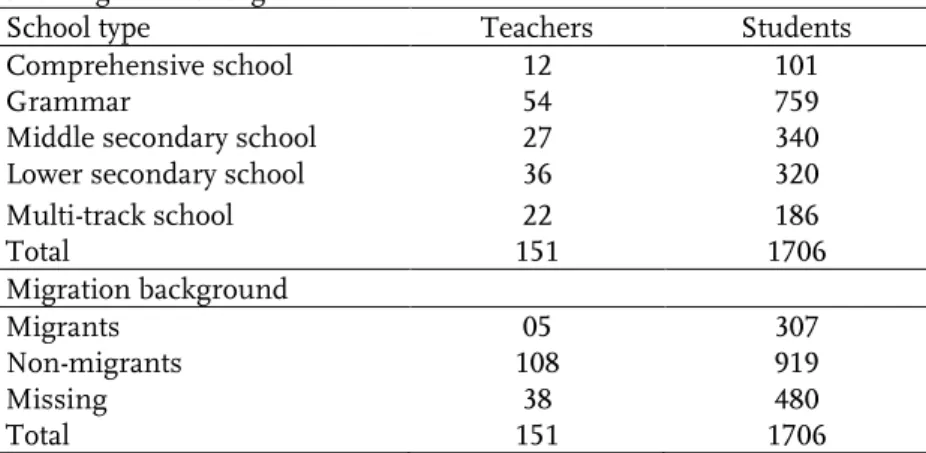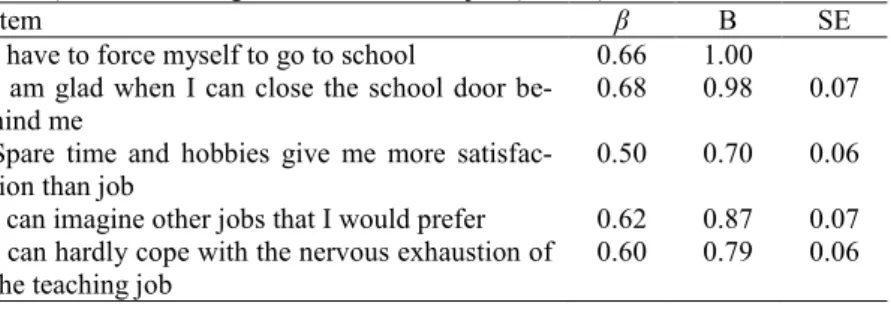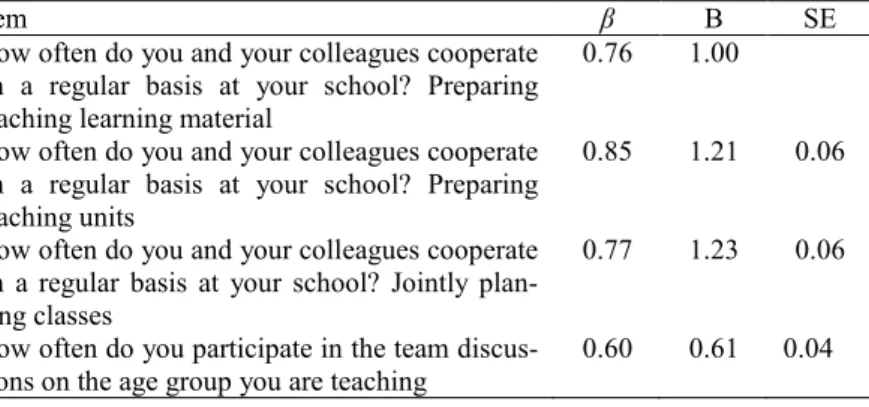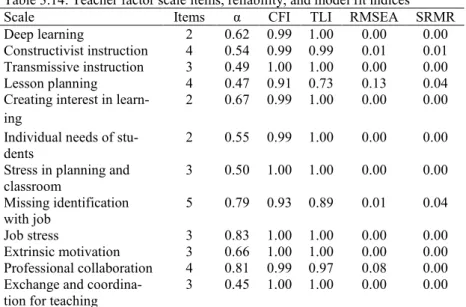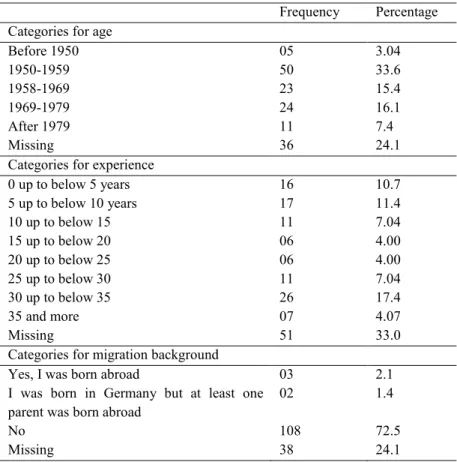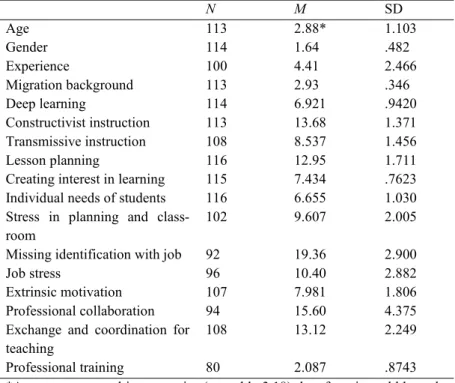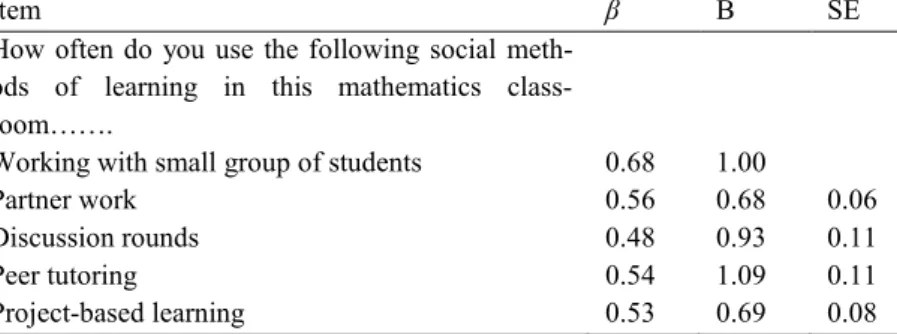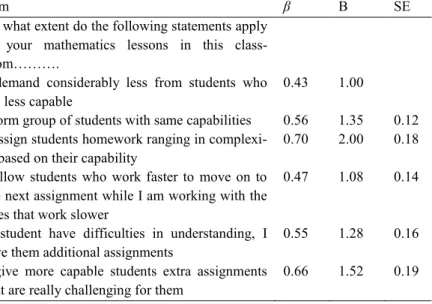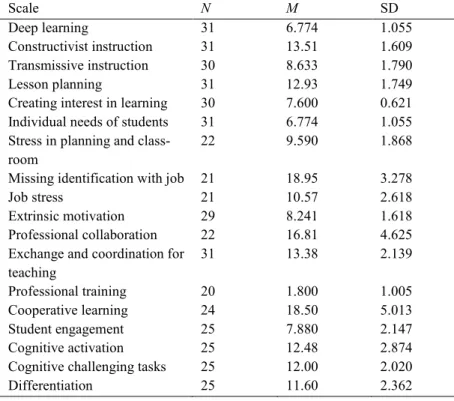Schriften aus der Fakultät Humanwissenschaften der Otto-Friedrich-Universität Bamberg
26
Saba Hanif
Distal and Proximal Indicators of Teacher Effectiveness
As Predictors of Students’ Mathematics Competence in Germany (Grade 5 – 7)
Schriften aus der Fakultät Humanwissenschaften
26
der Otto-Friedrich-Universität BambergSchriften aus der Fakultät Humanwissenschaften der Otto-Friedrich-Universität Bamberg
Band 26
2016
von Saba Hanif
2016
Distal and Proximal Indicators of Teacher Effectiveness
As Predictors of Students‘ Mathematics Competence in Germany (Grade 5 – 7)
Die Deutsche Nationalbibliothek verzeichnet diese Publikation in der Deut- schen Nationalbibliographie; detaillierte bibliographische Informationen sind im Internet über http://dnb.d-nb.de/ abrufbar.
Dieses Werk ist als freie Onlineversion über den Hochschulschriften-Server (OPUS; http://www.opus-bayern.de/uni-bamberg/) der Universitätsbiblio- thek Bamberg erreichbar. Kopien und Ausdrucke dürfen nur zum privaten und sonstigen eigenen Gebrauch angefertigt werden.
Herstellung und Druck: Digital Print Group, Nürnberg
Umschlaggestaltung: University of Bamberg Press, Anna Hitthaler
© University of Bamberg Press Bamberg, 2016 http://www.uni-bamberg.de/ubp/
ISSN: 1866-8674
ISBN: 978-3-86309-452-2 (Druckausgabe) eISBN: 978-3-86309-453-9 (Online-Ausgabe) URN: urn:nbn:de:bvb:473-opus4-478705
Diese Arbeit hat der Fakultät Humanwissenschaften der Otto-Friedrich- Universität Bamberg unter dem Titel „Distal and proximal indicators of teacher effectiveness as Predictors of students‘ mathematics competence
in Germany (Grade 5-7)“als Dissertation vorgelegen.
Gutachter: Prof. Dr. Claus H. Carstensen Gutachter: Prof. Dr. Cordula Artelt
Tag der mündlichen Prüfung: 11. Oktober 2016
To my parents
who valued and believed in me
First and foremost, I would like to express my sincere gratitude to my supervisors, Prof. Claus H. Carstensen, and Prof. Cordula Artelt. Their academic guidance and the in-depth discussions we had about my pro- ject made this research possible. I would also like to thank my third supervisor, Prof. Annette Scheunpflug. She always believed in me and her encouragement was like a fuel through the whole process of my doctoral studies. Furthermore, I am indebted to Prof. Ulrich Shroeders, who has provided me his immense support and guidance whenever I needed it.
Second, I would like to thank the Bamberg Graduate School of Social Sciences (BAGSS) and the Deutsche Forschungsgemeinschaft (DFG) for providing me with the opportunity to pursue my doctoral studies in Germany. I would also like to acknowledge the support provided by Miriam Schneider, Alexandra Wolf and Marc Scheibner that smoothed the journey of my studies in diverse regards.
Particularly, I would like to thank all my friends, who made my life in a foreign country easier with their presence that eventually helped me to keep my focus on my research. I am blessed to have friends like Ai Mi- amoto and Iris Reus. My special thanks go to my colleagues including Tobias Rausch, Yi-Jhen Wu, Ashenafi Kassahun Edossa, and Max Na- chbauer for their invaluable input which helped me to shape my re- search project in a better way.
I am grateful to my family for constant love and patience, even when my goals took me away from them. A very special thanks to my friends in Pakistan - Afshan, her husband Imran, Gull and Faiza - who are very close to my heart for the energy and enthusiasm which made me seek Ph.D. in Europe. Their confidence in me kept me going, although my family was full of doubt. I am extremely thankful to Allah, the most gracious and merciful, that He gave me the opportunity and courage to make the toughest but best decision of my life of doing Ph.D. abroad.
ii Contents
Chapter 1 Introduction of the Study ………... 1
1.1. Outline of the Study ……….………...………... 4
Chapter 2 Theoretical Background ……….………….…....……….. 5
2.1. Brief history of teacher effectiveness .……….….………… 5
2.2. Defining teacher effectiveness ………. 7
2.3. Models of teacher effectiveness ………... 9
2.3.1. Presage-product model ………... 9
2.3.2. Process-product model ………... 10
2.3.3 Dynamic model of educational effectiveness ………….. 11
2.3.4. Comprehensive model of educational effectiveness .. 14
2.3.5. Danielson model of effective teaching ……… 15
2.4. Distal and proximal indicators of teacher effective- ness ……….. 17
2.5. Teacher factors ……….. 18
2.5.1. Teacher belief ………. 19
2.5.2. Professional training ………. 23
2.5.3. Job satisfaction ……….. 26
2.5.4. Planning ……… 27
2.5.5. Cooperation among teachers ……… 28
2.5.6. Stress in planning and classroom ……….. 30
2.6. Instructional factors ……… 30
2.6.1. Cooperative learning ……….. 33
2.6.2. Student engagement ……….. 35
2.6.3. Cognitive activation ……… 36
2.6.4. Cognitively challenging tasks ……… 37
2.6.5. Differentiation ……… 39
2.7. Mathematics Competence ……….. 41
2.8. Operational definitions ………. 42
2.8.1. Teacher belief ………. 42
2.8.1.1. Belief about deep learning ……….. 43
2.8.1.2. Belief about constructivist instruction ……….. 43
2.8.1.3. Belief about transmissive instruction ……… 43
2.8.2. Planning ………... 43
2.8.2.1. Lesson planning ……….. 43
2.8.2.2. Planning about creating interest in learning ……… 43
2.8.2.3. Planning about individual needs of students ………. 43
2.8.3. Job satisfaction ……….. 43
iii
2.8.3.1. Missing identification with job ………. 44
2.8.3.2. Job stress ………... 44
2.8.3.3 Extrinsic motivation for job ……… 44
2.8.4. Stress in planning and classroom ……….. 44
2.8.5. Cooperation among teachers ……… 44
2.8.5.1. Professional collaboration ……….. 44
2.8.5.2. Exchange and coordination for teaching ………. 44
2.8.6. Professional training ………. 44
2.8.7. Cooperative learning ……….. 45
2.8.8. Student engagement ……….. 45
2.8.9. Cognitive activation ……… 45
2.8.10. Cognitively challenging tasks ……… 45
2.8.11. Differentiation ……… 45
2.8.12. Mathematics Competence ……….. 45
2.9. Analytical Framework ……… 46
2.10. The Research Gap ……… 49
2.11. Relevance of the study and research questions ………. 54
2.12. School System and Teacher Education in Germany .. 60
Chapter 3 Research Methodology ………. 63
3.1. National Educational Panel Study (NEPS) ……… 63
3.2. Why NEPS Data is used ……….. 65
3.3. Data collection ……… 67
3.4. Sample ……… 68
3.5. Instruments of the Study ……… 70
3.5.1. Teacher questionnaire ……….. 71
3.5.2. Demographic variables ………. 80
3.5.2.1 Gender ………. 81
3.5.2.2. Migration ……… 81
3.5.2.3 Age ……….... 81
3.5.2.4. Experience ……….. 81
3.5.2.5. Professional training scale ……….………. 81
3.5.3. Instructional questionnaire ……… 84
3.5.4. Mathematics competence test ……….. 91
3.6. Data Analysis ……….. 93
3.6.1 Research question 1 ……… 93
3.6.2. Research question 2 ……… 94
3.6.3. Research question 3 ……… 94
3.6.4. Research question 4 ……… 94
iv
Chapter 4 Empirical Findings ………. 101
4.1. Research Question 1 ……….. 104
4.1.1. Hypothesis 1 ……… 106
4.1.2. Hypothesis 2 ……… 107
4.1.3. Hypothesis 3 ……… 107
4.1.4. Hypothesis 4 ……… 108
4.1.5. Hypothesis 5 ……… 109
4.1.6. Hypothesis 6 ……… 109
4.1.7. Hypothesis 7 ……… 110
4.1.8. Hypothesis 8 ……… 111
4.1.9. Hypothesis 9 ……… 111
4.1.10. Hypothesis 10 ………. 112
4.1.11. Hypothesis 11 ………. 113
4.1.12. Hypothesis 12 ………. 114
4.1.13. Hypothesis 13 ………. 115
4.2. Research question 2 ……… 116
4.2.1. Hypothesis 14 ………. 116
4.2.2. Hypothesis 15 ………. 117
4.2.3. Hypothesis 16 ………. 118
4.2.4. Hypothesis 17 ………. 119
4.2.5. Hypothesis 18 ………. 120
4.3. Research question 3 ……… 121
4.3.1 Hypothesis 19 ………. 121
4.3.2. Hypothesis 20 ………. 122
4.3.3. Hypothesis 21 ………. 123
4.3.4. Hypothesis 22 ………. 124
4.4. Research question 3 ……… 127
Chapter 5 Discussion, Implications and Recommendations …… 132
5.1. Summary ……….. 132
5.2. Research Question 1 ……….. 134
5.2.1 Teacher belief ………. 134
5.2.2. Job satisfaction ……….. 136
5.2.3. Planning ……… 137
5.2.4. Stress in planning and classroom ………... 138
5.2.5. Cooperation among teachers ……… 139
5.2.6. Professional training ………. 140
5.3. Research question 2 ……… 141
5.3.1 Cooperative learning ……….. 141
v
5.3.2. Student engagement ……….. 142
5.3.3. Cognitive activation ……… 142
5.3.4. Cognitively challenging tasks ……… 143
5.3.5. Differentiation ……… 143
5.4. Research question 3 ……… 144
5.5. Research question 4 ……… 145
5.6. Limitations ……….. 146
5.7. Implications and Recommendations ……….. 148
6. List of figures ……….. 150
7. List of tables ………. 151
8. References ……… 156
9. Appendices ……….. 174
9.1. Appendix I ……… 174
9.2. Appendix II ……….. 176
9.3. Appendix III ……… 179
Chapter 1
Introduction
“Interventions at the structural, home, policy, or school level is like searching for your wallet which you lost in the bushes, under the lamppost because that is where there is light. The answer lies elsewhere – it lies in the person who gently closes the classroom door and performs the teaching act –the person who puts into place the end effects of so many policies, who interprets these policies, and who is alone with students during their 15,000 hours of schooling.”
(John Hattie, 2003, p.3)
The focus of research on educational effectiveness has turned from school effectiveness towards the effectiveness of the teachers as research in the recent past has shown that teachers are the most im- portant determinant of student learning. However, there is still a lack of consensus as to whether teacher variables or teaching variables are more important. A strong body of knowledge has shown the importance of teacher variables in student learning. Seidel and Shavelson (2007) claimed in their recent meta-analyses, however, that teacher variables are in fact distal indicators of effectiveness whereas teaching factors are the proximal indicators of teacher effectiveness. Therefore, Seidel and Shavelson assumed in their study that proximal factors are stronger predictors of student learning in comparison to distal factors. Distal and proximal factors are defined in terms of their proximity to the teaching- learning process. Seidel and Shavelson mentioned that correlational research which is the most dominant design used in teacher effective- ness research has often examined teacher effectiveness through distal indicators and very little research has used proximal indicators in educa-
2
tional effectiveness research. This might be the reason behind the weak effects of teacher and their teaching on student learning as shown by previous correlational studies in comparison to quasi-experimental and experimental studies. Although, Seidel and Shavelson found proximal indicators as more effective than distal indicators in their meta-analyses study, there is important evidence showing teacher factors are an indica- tor of student learning, for instance meta-meta-analyses of Hattie (2009), and this evidence cannot be ignored. Moreover, findings from a single meta-analysis study are not enough to diminish the significance of teacher factors. More research is needed in correlational studies to ex- plore this issue. Although, it may be true that proximal indicators are more important than distal indicators, the question is, do distal indica- tors have an effect on student outcomes? Are proximal indicators inde- pendent of distal indicators of learning? I believe not as teacher beliefs can affect teachers’ practices (Stipek et al., 2001) and teachers’ profes- sional knowledge can affect the nature and quality of classroom activities a teacher plans for the learning process. TALIS (2009) found that teacher belief, practices and attitudes affect the classroom learning environment and student learning. Although, it is beyond the scope of the current study to investigate how teachers’ factors shape teachers’ instruction, but the effect of teachers factors on student mathematics competence have been investigated directly assuming that teacher factors affect classroom instruction and hence student outcomes. The current study aims to measure the effectiveness of both distal and proximal indicators of teacher effectiveness in order to see which factors strongly predict stu- dent competence.
Recently there has been a growing interest in examining teach- ing and learning in domain-specific contexts. Seidel and Shavelson (2007) found that studies in domain-specific contexts showed a greater effect on student learning than domain-general studies. Baumert et al.
(2013) affirmed that teaching and learning are domain-specific and Hattie (2009) also provided the evidence that different teaching ap- proaches show different effects on student learning in different do-
3
mains. However, more evidence is needed on domain-specific learning.
Therefore the current study has mainly examined the proximal indica- tors of teacher effectiveness in a domain-specific context.
In order to get better insights about the role of the teacher, it is important to measure the effect of teachers and their teaching on stu- dents’ learning in natural settings. This is not possible with experi- mental or quasi-experimental studies in which the results could not be generalized to larger populations or in cross-sectional studies in which the effects might be from a previous teacher. It is important that the teacher has taught students for a meaningful period of time, hence the design of the current study is longitudinal in nature with representative data from Germany. As the data is from different types of lower second- ary schools in Germany, it offers the opportunity to analyze and com- pare the role of mathematics teachers and their teaching in students’
mathematics competence development among schools.
The first objective of the study is to examine if proximal indica- tors are more significant predictors of teacher effectiveness than the distal indicators. Distal indicators are rather general factors, for instance teacher beliefs, professional training, and job satisfaction. Proximal indica- tors are the domain-specific factors which are measured proximal to the process of learning for instance cooperative learning, cognitive activation, student engagement and cognitively challenging tasks.
The second main objective of the study is to find the combina- tion of teacher factors or teaching (instructional factors) or the combina- tion of both teacher and instructional factors that make a teacher effec- tive.
The third and the last objective of the study is to compare the teacher effectiveness among different school types and to see the role of teachers in each school type in their students’ mathematics competence development. Because the teachers in different school types in Germany are trained differently and, as Baumert et al. (2013) argued, teachers of
4
different school types differ in their characteristics, it’s important to examine if they also differ in their effectiveness.
1.1. Outline of the Study
The study is divided into five chapters. In chapter 2, the theoret- ical framework of the study is discussed in detail. At first, the history of teacher effectiveness, definitions of teacher effectiveness and models of teacher effectiveness are discussed briefly. Secondly, the idea of distal and proximal indicators of teacher effectiveness is explained, along with the description of each distal (teacher factors) and proximal (teaching factors) factor that are included in the current study and then mathemat- ics competence is described. Thirdly, the analytical framework of the study is detailed and research gap in the previous literature is identified.
Finally, the relevance of the study and research questions is discussed.
In chapter three, the methodological approaches and procedures used in the study are described. At first, the National Educational Panel (NEPS) is introduced along with the reasons for using NEPS data for the current study. Secondly, the data collection, sample and instruments of the study are explained in detail along with the results from the con- firmatory factor analysis. Finally the data analysis techniques that are used to analyze each research question are described. In chapter four, the results of the study are explained in detail for each research question and hypothesis. In chapter five, the findings of the study are discussed.
The main results of the study are summarized, and then the results from each research question are discussed. The limitations of the study are described and implications and recommendations are provided.
Chapter 2
Theoretical Background
The chapter covers the theoretical foundations and state of the empirical research on teacher effectiveness. The chapter briefly de- scribes teacher effectiveness, its history, theoretical models, empirical state of research, factors teacher effectiveness factors, analytical frame- work of the study, research gap and research questions of the current study. The history of teacher effectiveness explains how the concept of teacher effectiveness has developed overtime. Following this, the various ways in which different educational researchers have defined teacher effectiveness and the criteria for defining teacher effectiveness are dis- cussed. Theoretical models describing the basis of different aspects and elements of effectiveness and the empirical evidence regarding each model is provided. Teacher factors and instructional factors of teacher effectiveness are discussed as distal and proximal indicators of teacher effectiveness. The concept and the state of empirical research are de- scribed in relation to each construct and the expectations of the current research are discussed in relation to each construct. Finally the research questions are discussed in detail and the analytical framework of the current study is provided.
2.1. Brief History of Teacher Effectiveness
Mouly (1963) states that “teachers are humans and nobody ex- pects them to be perfect. But society has the right to expect certain effec- tiveness in promoting the purposes and objectives for which teachers and schools exist” (p.16).
Measuring teacher effectiveness is not a new subject; teachers used to be evaluated even in the days of one-room school, the evaluation used to be done locally through some locally developed standards at
5
6
school, for the purpose of job extension or increase in teacher salary (Markley, 2004).
With the industrial revolution, along with the other changes in societies, evaluation systems at schools also began to change. The indus- trial revolution brought the awareness that students are an asset of the nation and the future of the nation lies in the hands of children and consequently in the hands of teachers. Therefore, teachers’ personal characteristics were studied as a predictor of student outcomes. Re- search on teacher effectiveness began in the early 1920s with a number of studies referring to superior and inferior teachers with respect to their teaching quality and by the middle of the century such studies resulted in the formation of the American Educational Research Association (AERA) in 1952 (Doyle, 1977). The motivating factor behind this ad- vancement was the Sputnik crisis and the cold war between the USA and the USSR. It drew attention to the issue that American children’s education was lacking and resulted in improvements in teacher training and assessment (Markley, 2004). This led to the formation of theoretical models of teacher effectiveness (the models will be discussed later) in order to measure the components of teacher effectiveness. Later the idea of teacher effectiveness was broadened to school or educational effec- tiveness with the assumption that school level factors (e.g. school leader- ship, learning environment) do effect teacher behavior and hence stu- dent outcomes. Research then began in the area of educational effec- tiveness as school effectiveness and teacher effectiveness began to be considered as a part of educational effectiveness. The starting point for the educational effectiveness study was with the studies conducted by Coleman et al. in 1966 and Jencks et al. in 1972 in the United States of America (Creemers, n.a). These sociological studies attempted to reveal the relation between society and schools and found that inequality in educational opportunities is the major problem (Scheerens, 2000). Later the subject of school effectiveness was studied in the field of education and the key finding from the decades of research on school and educa- tional effectiveness is: the classroom level or teacher and teaching quali-
7
ty is the most important predictor of pupil outcomes (RAND, 2013;
Muijs & Reynolds, 2001; Kyriakides, Campbell, & Gagatsis, 2000;
Scheerens & Bosker, 1997; Brophy & Good, 1986; Kyriakides &
Creemers, n.a.).
But throughout its history, research on teacher evaluation has faced problems regarding theory, methodology and productivity. Most of the research on measuring teacher effectiveness (or educational effec- tiveness) is a-theoretical in nature and has focused on finding the statis- tical relationship between teacher factors and students’ outcomes with- out any concern about theory generation and testing (Creemers, 2002) and this problem exists till today. However, there is a consensus that teachers are the most important factor in the development of student learning and competence. Wenglinsky (2000) reported that what hap- pens in the classroom is critical for students and Sander (1999) affirmed that the teacher is the single biggest contributor to student performance.
The importance of teacher and teaching summed up nicely by Elmore (2009) as “to improve student learning, you do not change the structure.
You change the instructional practices of teachers. The schools that seem to do best are those that have a clear idea of what kind of instruc- tional practice they wish to produce, and then design a structure to go with it”.
2.2. Defining Teacher Effectiveness
Despite agreement that effective teaching is the most important factor that contributes to student achievement, there is still no widely accepted definition of teacher effectiveness. Furthermore, there is the lack of agreement about what constitutes effective teaching which has resulted in a broad range of definitions of teacher effectiveness.
Defining teacher effectiveness is intricate because the defini- tion, the elements of teacher effectiveness and the techniques of measur- ing it are strongly interconnected with each other and, hence, should be
8
in line with each other. Therefore, the definition of teacher effectiveness reflects the components of teacher effectiveness along with the meas- urement methods used to investigate it. For instance, Campbell et al.
(2004) defined teacher effectiveness as “the impact that classroom fac- tors such as teaching methods, teacher expectations, classroom organi- zation and use of classroom resources, have on students’ performance”
(p.78). From this definition, it is clear that teacher effectiveness is the effect of the procedures used by the teacher in classroom and the effects on student learning or competence development. It is also obvious from the definition that the method used to measure teacher effectiveness would probably be classroom observation. On the other hand, Doyle (2008) stated that “teacher effectiveness is the amount of student learn- ing that occurs” (p.2). From this definition we can interpret that teacher effectiveness is not directly related to the elements involved in teaching/
classroom and only concerned about student achievement and the effec- tiveness of the teacher is about the level of growth in student learning.
Swank, Taylor, Brady, and Frieberg (1989) defined teacher effec- tiveness is terms of specific teacher actions in classroom. They stated teacher effectiveness is asking more academic questions during instruc- tion, shrinking the lecture time and ineffective practices, like negative feedback and low-level questions. Teacher should ask cognitively chal- lenging questions, should avoid direct instruction and activities in which students cannot participate actively. They believed that teacher effective- ness in this way can be easily evaluated because all these factors can be easily observed during teacher instruction. Million (1987) stated effec- tiveness is centered on the lesson design and methods of delivery. Ac- cording to Smith (1995) teaching is about arranging the experiences in an effective way. Vogt (1984) stated that effective teaching is “the ability to provide instruction to different students of different abilities while incorporating instructional objectives and assessing the effective learn- ing mode of the students”. Clark (1993) wrote that “effective teaching involves someone who can increase student knowledge” (p. 10). Collins (1990) established the criteria for an effective teacher, based on five
9
characteristics; the effective teacher is committed to student learning, knows the subject matter well, is responsible for managing students, can think analytically about their own practice, and is a member of the learn- ing community.
Although, the above mentioned definitions have stated differ- ently but most of them have two things in common; teacher instruction and student learning which shows that both aspects are integral part of teacher effectiveness. Teacher effectiveness cannot be determined with- out knowing its effect on student outcomes. The current study will ad- here to this tradition and defined teacher effectiveness as “the effect of teacher and instructional factors on students’ mathematics competence from grade 5 to 7. In current study, factors that would show positive effect on student mathematics competences could be considered as ef- fective. In Walberg’s words “what’s good for the goose is good for the gander” (1984).
2.3. Models of Teacher Effectiveness
In the beginning of 1990s a strong interest came up in the theo- retical models on the educational effectiveness in reaction to the factors and characteristics of effective teachers. A number of empirical studies have examined the theoretical models of teacher (or educational) effec- tiveness and provided empirical findings regarding those models. The current study has briefly discussed those models and provided the em- pirical findings, for more details see Doyle (1986), Borich (1996), Scheerens (2004), Creemers (2002), Seidel and Shavelson (2007), Bolhu-is (2003).
2.3.1. Presage-product model
The presage-product model is the oldest model to measure teacher effectiveness. The model was based on the assumption that background characteristics and psychological characteristics of teachers make them more or less effective and these characteristics include
10
teachers’ age, intelligence, gender, motivation, professional training, and personality (like attitudes, authoritarianism and flexibility: Woolfolk 1985). In order to investigate it, personality characteristics of teachers have been measured using a variety of psychological tests (Campbell, Kyriakides, Muijis & Robinson, 2004). Schofield and Start (1980) stated that most of the research in teacher effectiveness until the late 1950s was done based on the presage-product model and gathered personality, experience, attitudes, education, socio-economic background as compo- nents of teacher effectiveness, however, the empirical evidence between presage variables and student outcomes was not convincing and there- fore, the approach was extensively criticized. Research found that gener- ally there is no relationship between teachers’ characteristics and stu- dent performance (Borich, 1996).
The reviews done by Medley and Mitzel (1963) and Gage (1965) on the studies of teacher effectiveness showed that there is no consisten- cy between the effects of teachers’ personal characteristics on students’
outcomes (presage-product model). The lack of consistency in the results between teacher characteristics and student outcomes and the emer- gence of behaviorist school of thought in student learning turned the focus of teacher effectiveness research from personal characteristics of teachers to their behavior in the classroom and therefore, teachers’ class- room behavior (process) and student outcomes (product) was measured.
2.3.2. Process-product model
When the psychological factors of teachers failed to explain the relation between teachers’ effectiveness and student competencies, re- searchers started looking into the role of teachers’ behavior on their effectiveness. The model was influenced from the theories of behaviorist psychologist, mainly Ivan Pavlov and B.F. Skinner.
The process-product paradigm was based on the assumption that the product (student learning) is the outcome of the process (class- room instruction). As the whole process of classroom instruction is con-
11
trolled by teachers, teachers’ behavior has an important role in student learning. Studies based on this model were mostly conducted in 1960s involving the measurement of student competencies at the beginning and end of the study, with standardized tests. Albert Bandura later add- ed motivation, thought, belief and expectations, in addition to behav- ioural factors, which also influenced the transition from the behaviorist school of thought to that of cognitive psychology.
Process-product studies have deepened the understanding of the teaching-learning process. Findings from research on process- product showed that specific teachers’ behaviors are consistently corre- lated with student achievement (Brophy and Good, 1986). Lowyck re- ported (as cited by Scheerens, 2004) the following teacher factors as predictors of students’ outcomes in process-product studies; clarity (clear presentation adapted to suit the cognitive level of students), flexibility (varying teacher behaviors, teaching aids and activities), enthusiasm, (in behavior), task related/ business like behavior, criticism, indirect activity (taking up ideas, accepting students’ feelings and stimulating self- activity), providing the students with opportunity to learn criterion mate- rial, making use of stimulating comments and varying the level of both cognitive questions and cognitive interaction. However, these specific behaviors were not enough to explain effective teaching, therefore, the question was how much the factors of teacher effectiveness need to be extended (Campbell et al., 2004).
2.3.3. Dynamic Model of educational effectiveness
The dynamic model of educational effectiveness was presented by Kyriakides and Creemers in the 1990s. The dynamic model of educa- tional effectiveness is a top to down model from state or regional policies to what occurs in classroom. The model involves all factors from school that can influence students’ outcomes. This model details all the factors of teaching quality which are given in table 2.1.
12
The model does not promote any single approach to teaching but rather explainshow the whole process of teaching should be conducted in the classroom. The model is grounded on the assumption that factors of teaching are interconnected and are not distinct from eachother (Campbell et al., 2003; Creemers, 2007; Johnson, 1997) so teaching quality cannot be achieved by concentrating on an isolated teaching approach rather by using the effective skills together from dif- ferent teaching approaches (Gilberts & Lignugaris-Kraft, 1997). Howev- er, the model was criticized also for the same reason i.e. it is only con- cerned with the increase in student performance, neglecting the fact that those teaching skills are not in line with each other and belonged to different teaching approaches (Creemers & Kyriakides, 2008). Nonethe- less the model was supported by findings from some recent studies. For instance Antoniou, Kyriakides and Creemers (2011) conducted an exper- imental study in order to investigate the effectiveness of dynamic inte- grated approach (DIA) to teacher professional development and student performance. The study was conducted by creating two
Table 2.1: Showing teacher level factors of dynamic model is educational effectiveness
Factors Main Elements
(1) Orientation (a) Providing the objectives for which a specific task/ lesson/series of lessons take(s) place; and (b) challenging students to identify the reasons for which an activity takes place in the lesson.
(2) Structuring (a) Beginning with overviews and/or review of objectives; (b) outlining the content to be cov- ered and signaling transitions between lesson parts; and (c) calling attention and reviewing main ideas.
(3) Questioning (a) Raising different types of questions (i.e., process and products) at appropriate difficulty level; (b) inviting students to develop strategies;
and (c) promoting the idea of modeling.
13
(4) Teaching modeling (a) Encouraging students to use problem solv- ing strategies presented by the teachers or other classmates; (b) inviting students to develop strategies; and (c) promoting the idea of model- ing.
(5) Application (a) Using seatwork or small group tasks in order to provide needed practice and application opportunities; and (b) using application tasks as starting points for the next step of teaching and learning.
(6) Classroom as a learning environment
(a) Establishing on task behavior through the interactions they promote (i.e., teacher-student and student-student interactions); and
(b) Dealing with classroom disorder and stu- dent competition through establishing rules, persuading students to respect them and using the rules.
Management of time (a)Organizing the classroom environment; and (b) maximizing engagement rates.
Assessment (a)Using appropriate techniques to collect data on student knowledge and skills; (b) analyzing data in order to identify student needs and report the results to students and parents; and (c) evaluating their own practices
Source: Creemers and Kyriakides. Enhancing quality in education: A dynamic model of educational effectiveness for research and practice.
intervention groups, one for DIA and the other for holistic approach (HA). HA aimed at teacher’s reflection of his own behavior regarding his teaching beliefs, practices and experiences in order to improve his effec- tiveness (Golby & Viant, 2007).The study found that teacher performing high on the factors of quality teaching in the dynamic model are more effective than teachers who performed low. The study also compared the effectiveness of (DIA) and holistic approach (HA) and found that the
14
dynamic approach is found to be more effective than the holistic ap- proach in terms of student achievement; however, the findings are not conclusive.
2.3.4. Comprehensive model of educational effectiveness
Creemer’s Comprehensive model of educational effectiveness presented in 1994 is actually the Caroll’s model of school learning. The Caroll’s model stated that ‘the degree of mastery is a function of the ratio of the amount of time students actually spend on learning tasks to the total amount of time they need (Kyriakides, Campbell & Gagatis, 2010).
Caroll (1963) argued that time actually spent on learning is defined as equal to the sum of three variables: opportunity, perseverance (to learn) and aptitude. In his model both opportunity and time are defined at the level of classroom and school. Creemers model is based on the following four assumptions: maximizing class time, successful grouping and organization, exhibiting best teacher practices, adapting practice to par- ticulars of classroom (Creemers, 1994). The model is based on the antic- ipation that among school factors, classroom is the most important.
Therefore, the quality of teaching in the classroom is important for stu- dent learning for instance effective teachers would take less time in classroom management, arranging the materials and would spend more time on learning tasks and activities, thus students would have more time to learn. However, Creemers did not present students as passive learners, if time and opportunity are in hands of teachers, eventually students would decide how much time they will spend on the learning activities and how better they would avail the learning opportunity. The model is based on the assumption that educational effectiveness has a hierarchical structure of levels; context level, school level, classroom level and student level.
According to this model, classroom factors contribute to lower level of effectiveness and the school and the context factors contributes to the higher level of effectiveness. The low level is defined not in the
15
terms of low importance rather in the terms of hierarchy considering the structure of school, classroom is the lowest level and national context is the highest level that develops educational policies. Lower level of effec- tiveness is conditional to higher level of effectiveness however; both levels together contribute to student outcomes. The contribution to ef- fectiveness at the lower levels comes from teacher and the students and the contribution at the higher levels includes educational policies, cur- riculum, school leadership, and school climate. The levels in the model effect student performance for instance time on task and opportunities used by students depends on the time and opportunity and quality of instruction offered by the teacher (Creemers, n.d.). The model has four principles necessary to achieve educational effectiveness. The first prin- ciple is consistency which means the consistency of effective features within and between levels; cohesion implies that all the teachers in school should be effective; constancy principle implies that teaching should be effective during all schools years of student and the last principle control implies outcomes and school environment should be evaluated (Creemers, 1994). It’s not easy to apply this model in real life because of the conditions for the application (like all school teachers should be effective) and most of the studies failed to provide the proof about the validity of the model.
2.3.5. Danielson model of effective teaching
Danielson (1996) created a model of effective teaching based on behaviorist theories in which she mentioned four domains of effective teaching which have showed to improve students’ learning by empirical studies and theoretical research. These domains include planning and preparation, classroom environment, instruction and professional re- sponsibilities. The sub-factors that contribute to each domain are given in the table 2.2. The model was criticized for being dealing students as passive learners.
16
Although, teacher effectiveness models have provided some basic and important knowledge about the factors of teacher effective- ness, they lack enough empirical evidence to support their argument and the findings are inconclusive about the factors of teacher effective- ness. Moreover, the models were dominated by the theory of behavior- ism i.e. teacher as a dominant figure of the learning process and the student as the less active figure in comparison to other schools of thoug- Table 2.2: Danielson model of effective teaching
Domain 1: Planning and Prepara- tion
1a Demonstrating Knowledge of Content and Pedagogy
1b Demonstrating Knowledge of Students
1c Setting Instructional Outcomes 1d Demonstrating Knowledge of Resources
1e Designing Coherent Instruction 1f Designing Student Assessments
Domain 2: Classroom Environ- ment
2a Creating an Environment of Respect and Rapport
2b Establishing a Culture for Learning
2c Managing Classroom Proce- dures
2d Managing Student Behavior 2e Organizing Physical Space Domain 4: Professional Responsibil-
ities
4a Reflecting on Teaching 4b Maintaining Accurate Records 4c Communicating with Families 4d Participating in a Professional Community
4e Growing and Developing Profes- sionally
4f Showing Professionalism
Domain 3: Instruction
3a Communicating With Students 3b Using Questioning and Discus- sion Techniques
Source: Danielson (1996) Danielson model of effective teaching.
ht of learning. If we look into the learning theories other than behavior- ism for instance Ausubel’s theory of meaningful learning, cooperative
17
learning theory, and Vygotsky socio-cognitive theory of learning, learn- ers actively participate in the process of learning. In the 21st century, the aim of education is to make the student an independent thinker, there- fore, the student should be more responsible for their learning especially at secondary level where students are able to regulate their learning.
Therefore, these models of teacher effectiveness are less beneficial. Fur- thermore, they have neglected the domain-specific aspect of learning and provided similar methods for all types of learning domains. Current studies in the field of educational research aim to measure teachers’
effectiveness in a domain-specific context for instance the Teaching and Learning International Survey (TALIS). Another current topic in the field explores teachers’ usage of constructivist learning activities in com- parison to behaviorism, for instance professional competence of teach- ers, Cognitive Activating Instruction and Development of Students’
Mathematics Literacy (COACTIV). Therefore, the recent models of teacher effectiveness are also inclined towards the domain-specific as- pect of learning and constructivist learning activities. Bolhuis’ model of instructional effectiveness is one of those and is discussed in this chap- ter in detail under the heading instructional factors along with the exten- sion of the model done by Seidel and Shavelson in (2007) for their meta- analysis study.
2.4. Distal and Proximal Indicators of Teacher Effec- tiveness
Current models of teacher effectiveness measure teacher effec- tiveness proximal to the process of teaching and learning rather than distal factors such as teacher factors. The idea of proximal indicators to the teaching-learning process is introduced by Seidel and Shavelson (2007) in their meta-analysis in which they found that proximal indica- tors are better indicators of measuring teacher effectiveness. Proximity is a matter of degree. The proximal indicators of measuring teacher effec- tiveness discussed by Seidel and Shavelson (2007) are experimental
18
methods and quasi experimental because both methods are quite close to the process of instruction. However, both methods are expensive ways of data collection and therefore, data is usually collected in small sam- ples that lack in generalizability. The study has found that teacher effec- tiveness research is dominated by correlational studies in which distal indicators are used to measure teacher effectiveness which they suggest is not the best way of measuring teacher effectiveness. Therefore, in correlational research there is a need to measure the instructional pro- cess and in correlational studies with large samples instruction is usually measured proximally by asking teachers or their students about the in- structional process. Therefore, the current study is correlational in na- ture but has taken into account the idea of proximally measuring the teaching-learning process through an instructional questionnaire that directly asked teachers about their practices in the classroom. Although, proximal indicators may be the better way of measuring teacher effec- tiveness, does it mean teacher factors are no longer important? Teacher factors are important as they have the power to shape teachers’ instruc- tion. Empirical studies have shown that teacher factors (distal indicators) influence instructional practices (Stipek, Givvin, Salmon & Macgyvers, 2001) and also student outcomes (Seidel & Shavelson, 2007). However, according to Seidel and Shavelson (2007) teacher factors are a less relia- ble way of measuring teacher effectiveness, but they are still important.
Although the power of distal indicators of teacher effectiveness shouldn’t be underestimated, proximal indicators may be the better way of meas- uring teacher effectiveness. Therefore, the current study aims to meas- ure teacher effectiveness not only through instructional factors (proxi- mal indicators) but also through teacher factors (distal indicators).
2.5. Teacher Factors
Baumert and Kunter (2013) affirmed that teachers play the most important role in the education system. Hattie stated that “the current mantra is that teachers make the difference” (2009, p.34). Therefore, abundant efforts are made in order to make teachers competent and
19
effective. In Germany, teachers are trained in both subject-matter knowledge and pedagogical knowledge to ensure they are able to cope with the challenges they will face in the classroom and help children learn to their potential. Moreover, teachers are trained in relation to the school type in which they will teach. However, the research shows that although teacher training is systematic and well planned teachers are not effective in a similar way and it might be because there are certain hab- its, beliefs and pedagogical ideals of teachers that influence their teach- ing. Some previous studies have reported that teachers’ practices are influenced by their general beliefs. For instance Baumert et al. (2010) have conducted a longitudinal study and have shown that teachers' be- liefs and knowledge are related to students’ outcomes and this relation was mediated by instructional practices. This shows that there are some factors that influence teacher instruction e.g. teachers beliefs, approach- es, pedagogical ideals, job satisfaction etc. Although, the findings are not conclusive, the previous research has shown that these factors have an effect on students’ outcomes. Therefore, the current study aims to measure the effect of teacher factors on student outcomes in order to get a better understanding and empirical evidence about the effect of teach- er factors. Each teacher factor is discussed here in detail.
2.5.1. Teacher belief
The belief is something that is hidden and inferential. It can on- ly be inferred or indirectly observed from the teacher’s responses or practices. Although hidden, beliefs play an important role in the teach- er’s decision making process about the instruction. Nespor (1987) con- cluded that beliefs are more important than knowledge in determining individuals’ behavior and way of organizing the tasks.
Teacher’s own belief is thought to function as a filter influencing decisions and actions made before, during and after instruction (Philipou and Christou, 1997). Teacher’s philosophy and beliefs were found to have an impact on students’ achievement, teachers’ attitudes about
20
the effectiveness of various teaching methods, innovations, curricula, textbooks and software material (Ernest 1999, Philippou and Christou 1997, Roulet 2000). Class organization, the choice of learning activities, the question posed by teachers and homework that teachers assign to students are likely to be influenced by teacher’s beliefs (Stipek et al., 2001).
In a study conducted by Campbell, Kyriakides, Mujis, Robinson (2004) teachers characterized by connectionist beliefs were found effective in comparison to teachers with direct transmission beliefs and discovery based learning orientations. According to Askew et al. (1997) connec- tionist teachers believe that being numerate involves being both efficient and effective, being able to choose an appropriate problem-solving or calculation method and being able to make links between different parts of the curriculum and not only the learning of facts. Thompson (1992) has stated that relationship between beliefs and practice is a two way relationship in which practical experience shape beliefs. The process- product model also supports the idea that teacher beliefs are determinants of teacher effectiveness. Although, there are studies that support the argument that beliefs shapes teachers’ instruction in the classroom (TALIS, 2009), there are studies that shows no relationship between teachers’ beliefs and practices. Wilcox-Herzog (2002) conducted a study on early childhood trained teachers beliefs about developmentally appropriate practices (DAP). The data about teacher belief was collected through a self-report questionnaire and teachers’ instruction was measured through videotapes. The study found no relationship between teachers’
beliefs and practices. The past studies have explored teachers’ beliefs about different dimensions for instance about DAP, learning strategies (Kist- ner, et al., 2015) etc. and the findings from those studies cannot be gen- eralized to teachers’ beliefs to other dimensions. The findings from the studies which explored direct instruction and constructivism are also inconclusive. Moreover, in the current era, teaching and learning are domain-specific; TALIS (2009) stated that little research has been done about teachers’ beliefs in relation to the subject being taught and TALIS itself has measured the domain-general aspects of teachers’ belief.
21
Therefore, it would be worth exploring the relationship between teachers’
belief and practices in a domain-specific context. The current study has measured the four dimensions of teachers’ beliefs: belief about deep learning, aim of education, constructivism and direct instruction.
If a teacher believes that learning should be deep, they would plan and provide the learning opportunities for students that would take them from ideas to understanding and beyond, surface learning, on the other hand, is when a teacher believes that students should simply learn the facts and figures. Biggs & Collis (1982) have done a study about deep learning and reported that various teachers claimed that the aim of their teaching is to improve deep learning. Surface learning is not unimportant of course as it provides a base for deep learning, but in the 21st century where the aim is to make a child an independent learner and thinker, they should be trained to construct meaning and meaningful experienc- es in the light of the knowledge attained from the teacher. This can only be possible if a teacher believes that learning should be in-depth. Hattie (2009) stated that learning would be successful if students became their own teachers and to achieve this teachers need to make students partici- pate in the learning process actively, let them know different ways to solve the problems, to provide opportunities to apply the learned knowledge and to monitor their learning. Pajares (1992) stated that be- liefs have a key role in teachers’ perceptions and decision making, which directly affect their teaching practices. A positive belief about deep learn- ing would make teachers plan in-depth learning. Planning of deep learn- ing activities is essential for cognitive activation and construction of knowledge in students. Bransford et al. (2000) stated that learning needs development of meaning and in-depth understanding of learning con- tent. Teachers’ positive beliefs about deep learning shows teachers’ high expectations from their students and previous research has shown that teachers’ high expectations have a positive influence on student out- comes.
22
A teacher having a constructivist belief would provide an oppor- tunity to learner to construct and reconstruct the idea and the aim is not to understand the idea rather the learners’ construction of ideas.
Scheerens (2004) stated that “students are to be confronted with “contex- tual real world environments. Or rich artificial environments simulated by means of interactive media” (p. 31)
As the name suggests transmissive beliefs implies the transmis- sion of facts directly to the students. This approach conceives the learner as a passive recipient. On the other hand, constructivist beliefs are based on the theory of involving the learner actively in the learning process.
For the constructivist school of thought, learning is a journey from ideas to comprehension and to construction of knowledge and onwards. A constructivist teacher claims that their role is that of a facilitator that provides learning opportunities to the individual students to attain knowledge and build (construct) understanding through their own activ- ities and through arguments, reflecting on the issue and sharing the ideas with other learners with a minimum interference and correction from the teacher (Cambourne, 2003). A teacher with transmissive beliefs would focus on basic skills, pre-specified objectives, small steps, feed- back and reinforcement, on the other hand a constructivist teacher focus- es on intrinsic motivation, challenging problems, discovery learning and context-based knowledge (Scheerens, 1995). TALIS (2009) mentioned that
“close monitoring, adequate pacing and classroom management as well as clarity of presentation, well-structured lessons and informative and encouraging feedback – known as key aspects of direct instruction – have generally been shown to have a positive impact on student achievement.”(p. 89)
Now most of the educational researchers and educational poli- cies want to see the learner as an active participant in the learning pro- cess and therefore support the constructivist approach. Scheerens and Bosker, (1997) however concluded that most effective teaching involves highly structured learning, direct teaching that is followed by testing and
